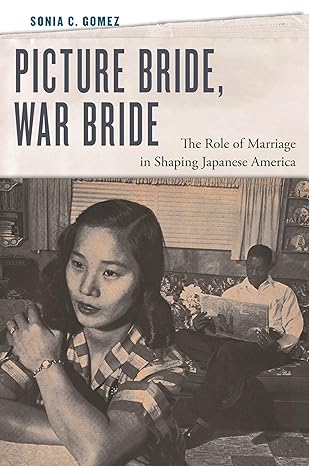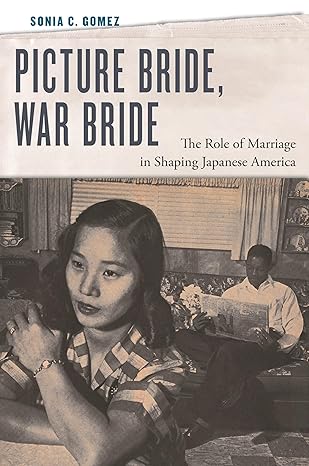
The Book
Picture Bride, War Bride: The Role of Marriage in Shaping Japanese America
The Author(s)
Sonia C. Gomez

In Picture Bride, War Bride: The Role of Marriage in Shaping Japanese America, Sonia C. Gomez (2024) offers a new account of Japanese American immigration history, using gender as a critical axis to challenge established historiography. Much discussion of Japanese immigration to the United States has revolved around the earliest wave of laboring men, whose arrival start after the 1882 Chinese Exclusion Act and end with the Gentlemen’s Agreement in 1908. “By making the primary focus the exclusion of men,” she argues, “many scholars have failed to attend to the gendered dimensions [of the Gentlemen’s Agreement].”[1] As she points out, Japanese wives of the laborers were allowed to enter the U.S. as “picture brides” until the National Origins Act in 1924. Thus between 1908 and 1924, a first wave of women (widely known to be about 10,000) arrived in the U.S. After the end of World War II, between 1947 and 1955, a second wave of nearly 13,000 Japanese women newly immigrated to the U.S., as wives of American military personnel stationed in Japan.
With sustained focus on these two major mass migrations of Japanese women shaped by marriage and institutionalized heteronormativity, and on the relationship between the two groups, Gomez’s interdisciplinary account seeks to move beyond an exclusive emphasis on the west coast Japanese immigration history[2] found in more traditional accounts: “Building on the work of sociologist Catherine Lee, this book interrogates how ‘race making and gender construction were constitutive of immigration control’ in the case of Japanese immigration to the U.S.”[3] Gomez grounds her thorough explorations of key legislations and studies in archival research, often skillfully bringing stories of individuals to life from careful distillation of historical records, and is indeed remarkable in her alertness to racial dynamics.
An obvious challenge for this project, when it comes to sensitively engaging Japanese American immigration history, is the centrality of wartime incarceration which shaped the lives of 126,000 individuals during World War II. “Much has been written about the disruption WWII incarceration had on family life,” Gomez asserts in her chapter focusing on unmarried Japanese men who were incarcerated, “but for marginalized Issei men who did not have families of their own, the experience of wartime incarceration differed.”[4] Certainly, writing a gendered history of immigration should not simply mean adding women to historical accounts of migration.[5] Gomez’s inclination to turn to “the margins,” in these stories of bachelor men and burakumin in the U.S., resonates with Elena Tajima Creef’s important work in Seeing Japanese/ American and Ainu Women in Photographic Archives (2022). Nevertheless, mass relocation and dispossession from designated zones in the west coast was a devastating fate awaiting the women who initially came to the U.S. as “picture brides,” and passing over the extreme difficulties that these same women faced at a later stage of their lives under harsh living conditions, not to mention their subsequent struggles of resettlement, could be seen as a curious and troubling omission.
[1] Sonia C. Gomez, Picture Bride, War Bride: The Role of Marriage in Shaping Japanese America (New York University Press, 2024),12.
[2] ibid., 7.
[3] ibid., 4.
[4] ibid., 52.
[5] ibid., 37.
About the Reviewer
Rei Magosaki is Associate Professor of English at Chapman University. She is author of Tricksters and Cosmopolitans: Cross-Cultural Collaborations in Asian American Literary Production (2016).






